Rubin Observatory
Astronomy and Telescopes
Rubin Observatory of the US NSF (National Science Foundation) / Former LSST
Status Rubin Observatory LSST Camera References
Overview
The Vera C. Rubin Observatory, currently under construction on Cerro Pachón in Chile, will conduct an unprecedented, decade-long survey of the optical sky called the Large Survey of Space and Time (LSST). The Rubin Observatory has a wide-field reflecting telescope with an 8.4-meter primary mirror that will photograph the entire available sky every few nights. The telescope uses a novel 3-mirror design, a variant of TMA (Three-Mirror Anastigmat), which allows a compact telescope to deliver sharp images over a very wide 3.5º diameter field of view.
Location: The telescope is located on the El Peñón peak of Cerro Pachón, a 2,682-meter-high mountain in the Coquimbo Region, in northern Chile, alongside the existing Gemini South and Southern Astrophysical Research Telescopes (location: 30º14'40.68''S, 70º44'57.90''W). The LSST Base Facility is located about 100 km away by road, in the town of La Serena. 1)

Vera C. Rubin Observatory Project Mission Statement: 3)
Rubin Observatory's mission is to build a well-understood system that will produce an unprecedented astronomical data set for studies of the deep and dynamic universe, make the data widely accessible to a diverse community of scientists, and engage the public to explore the Universe with us.
The goal of the Vera C. Rubin Observatory project is to conduct the 10-year Legacy Survey of Space and Time (LSST). LSST will deliver a 500 petabyte set of images and data products that will address some of the most pressing questions about the structure and evolution of the universe and the objects in it. The Rubin Observatory LSST is designed to address four science areas:
• Probing dark energy and dark matter.
• Taking an inventory of the solar system.
• Exploring the transient optical sky.
• Mapping the Milky Way.
The scientific questions that Rubin Observatory will address are profound, and yet the concept behind the design of Rubin Observatory is remarkably simple: conduct a deep survey over an enormous area of sky; do it with a frequency that enables images of every part of the visible sky to be obtained every few nights; and continue in this mode for ten years to achieve astronomical catalogs thousands of times larger than have ever previously been compiled.
The construction phase of the project will deliver the facilities needed to conduct the survey: a large-aperture, wide-field, optical imaging telescope; a gigapixel camera; and a data management system.
Camera: The Rubin Observatory LSST Camera must produce data of extremely high quality with minimal downtime and maintenance. In order to take advantage of high-quality images produced over such a wide field, the camera contains over three billion pixels of solid state detectors.
Data Management: Software is one of the most challenging aspects of Rubin Observatory, as more than 20 terabytes of data must be processed and stored each night.
Financial support for Rubin Observatory comes from the National Science Foundation (NSF) through Cooperative Agreement No. 1258333, the Department of Energy (DOE) Office of Science under Contract No. DE-AC02-76SF00515, and private funding raised by the LSST Corporation. The NSF-funded Rubin Observatory Project Office for construction was established as an operating center under management of the Association of Universities for Research in Astronomy (AURA). The DOE-funded effort to build the Rubin Observatory LSST Camera (LSSTCam) is managed by the SLAC National Accelerator Laboratory (SLAC).
The National Science Foundation (NSF) is an independent federal agency created by Congress in 1950 to promote the progress of science. NSF supports basic research and people to create knowledge that transforms the future. — NSF and DOE will continue to support Rubin Observatory in its Operations phase. They will also provide support for scientific research with LSST data.
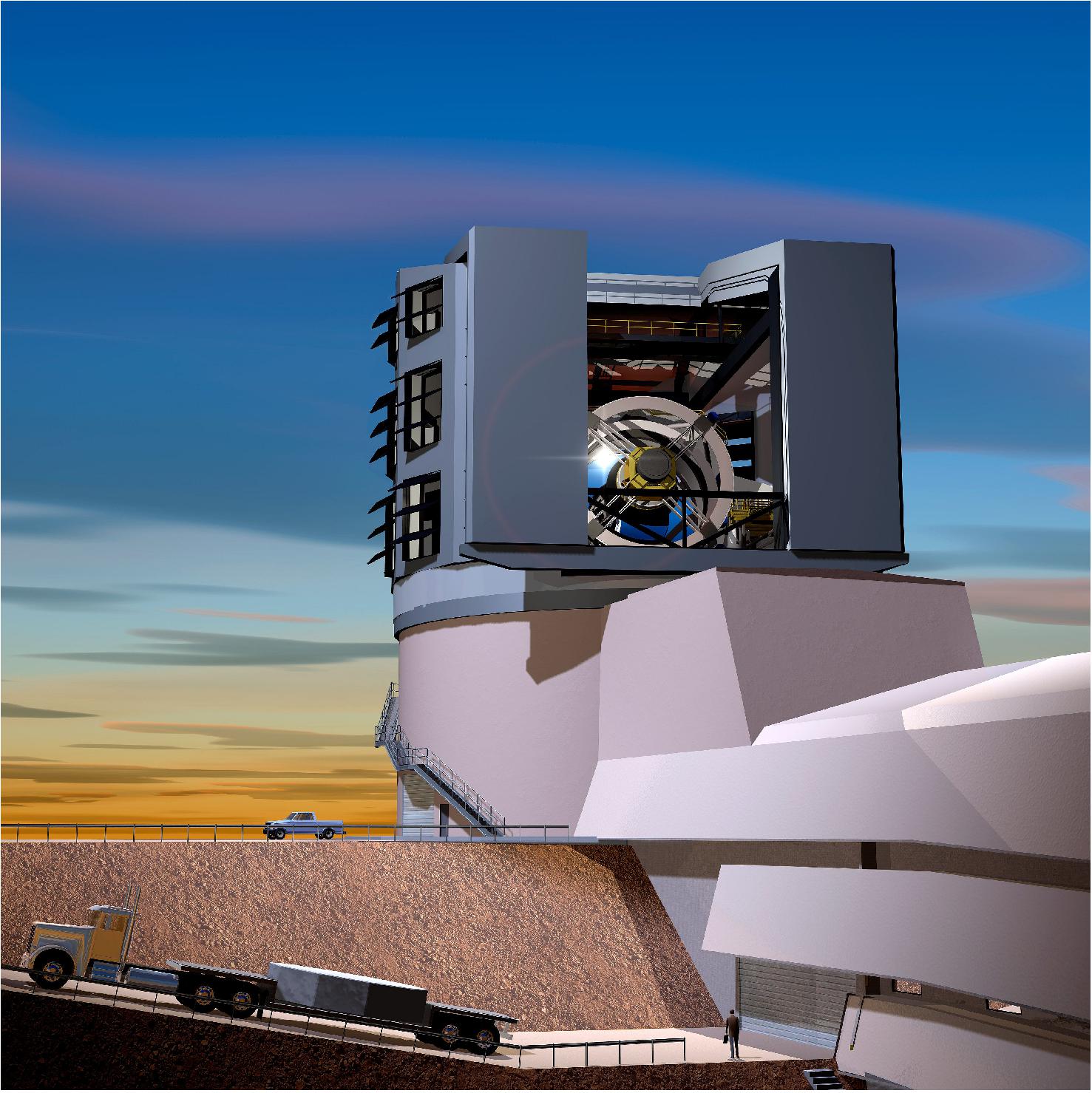
Figure 2: In this artist's rendition, the Rubin Observatory primary mirror is seen through the slit of the dome at sunset (image credit: Todd Mason, Mason Productions Inc. / LSST Corporation)
Vera C. Rubin Observatory is a joint NSF and Department of Energy (DOE) project that was ranked as the top large ground-based astronomy project recommended by the National Academies of Sciences, Engineering, and Medicine 2010 Astronomy and Astrophysics decadal survey: New Worlds, New Horizons in Astronomy and Astrophysics. Rubin Observatory's mission is to build a well-understood system that provides a vast astronomical data set for unprecedented discovery of the deep and dynamic Universe. Currently under construction on Cerro Pachón in Chile, Rubin Observatory consists of an 8.4-meter wide-field ground-based telescope, a 3.2 gigapixel camera, an automated data processing system, and a public engagement platform. This integrated survey system is designed to conduct a deep, wide, fast time-domain survey of nearly half the sky.
With a cadence enabling repeat observation of each survey field approximately twice weekly for the first ten years of operation, Rubin Observatory will perform the Legacy Survey of Space and Time (LSST) using the Rubin Observatory LSST Camera and the Simonyi Survey Telescope. During that time Rubin will acquire, process, and make available a collection of over 5 million images and catalogues with more than 37 billion astronomical objects and 7 trillion sources. Tens of billions of time-domain events will be detected and alerted upon in real time. The survey is expected to begin in FY 2024.
The requirements for Rubin Observatory and the survey were set by considering four key science areas: (1) the physics of dark energy and dark matter; (2) a census of small bodies in the Solar System, including potentially hazardous Near-Earth Objects (NEOs); (3) the structure and contents of the Milky Way Galaxy; and (4) the nature of transient astronomical objects on time scales ranging from seconds to years. By satisfying the requirements defined by these science areas, Rubin Observatory's initial survey will result in a comprehensive data set that will enable hundreds of fundamental astrophysical studies by the entire research community on these and other topics. As a result, Rubin Observatory has the potential to advance every field of astronomical study, from the inner Solar System to the large-scale structure of the Universe.
Not only will Rubin Observatory serve every area of astronomy and astrophysics research and education, but it will also serve studies in massive data analysis, high speed computing, high-bandwidth networking, and real-time analysis of large throughput time-variable data. With ongoing concerns about the danger posed by natural NEOs, the survey capability of Rubin Observatory is of significant interest beyond the scientific disciplines.
The responsible awardee for Rubin Observatory construction is the Association of Universities for Research in Astronomy, Inc. (AURA), a non-profit science management corporation. AURA is also the responsible awardee for Rubin Observatory pre-operations ramp-up activity that began in October 2018. Rubin pre-operations activity is fully integrated into NSF's National Optical-Infrared Astronomy Research Laboratory (NOIRLab).
The Rubin Observatory Project is a partnership between NSF and the U.S. Department of Energy (DOE) Office of High Energy Physics with NSF as the lead agency. DOE is providing the world-leading digital camera and is contributing to design, development, installation, commissioning, operations, and scientific research support. The DOE-funded effort is managed by the SLAC National Accelerator Laboratory.
Development Status
• November 12, 2021: The LSST Camera team at SLAC National Accelerator Laboratory celebrated a very cold day during the last week of October—not because of the weather, but because both of the systems that keep the LSST Camera cool were running successfully together for the first time since January 2021. 5)
- The LSST Camera generates a lot of heat—because of its size it produces about ten times more heat than early astronomical cameras. In order for the LSST Camera to operate without vibration (which would affect image quality), its components need to be cooled to very low temperatures. The Camera team has developed two separate systems to achieve this: the "Cold" system, which cools the raft electronics, and the "Cryo" system, which cools the camera's CCDs.
- The Cold and Cryo systems were operating together early in 2021, but at that time the Cryo system was operating with temporary (integration and testing) heat exchangers, and the Utility Trunk wasn't yet connected to the Cryostat. There were also some performance issues with the Cold system that needed to be solved. All of this work took place in the intervening months, and in September the Camera team was ready to start the multi-step process necessary to get both the systems running again.
- The Cold system was started up first, on September 27th, and was soon cooling the raft electronics to a range between ±10ºC . The improvements made by the team had resolved previous performance issues, and the system was running smoothly.
- Next came preparation for the startup of the Cryo system. This involved a number of careful and specific steps, especially since it was the first time running the system with the production heat exchangers. Each of the six circuits of the Cryo system was deliberately turned on, then off, then on again. And with that, the system began to cool the CCDs— ultimately reaching a very chilly -100°C. Both the Cold and Cryo systems take between 12-18 hours to reach their full cooldown temperatures.
- Now that both systems are running successfully, the Camera team will begin a full suite of Electro-Optical tests to optimize the performance of the focal plane (which includes the CCDs, readout board electronics, and thermal systems). This will be followed by a complete set of verification tests with nearly-final operating conditions. These tests will involve collecting about six weeks of data (in the form of many, many images), and testing a variety of factors like diffusion, read noise, dark or hot pixels or columns, gain, cross-talk, non-linearity, brighter-fatter, and charge transfer inefficiency. Which is all to say that the LSST Camera is getting closer and closer to being ready to ship to Chile in 2022!
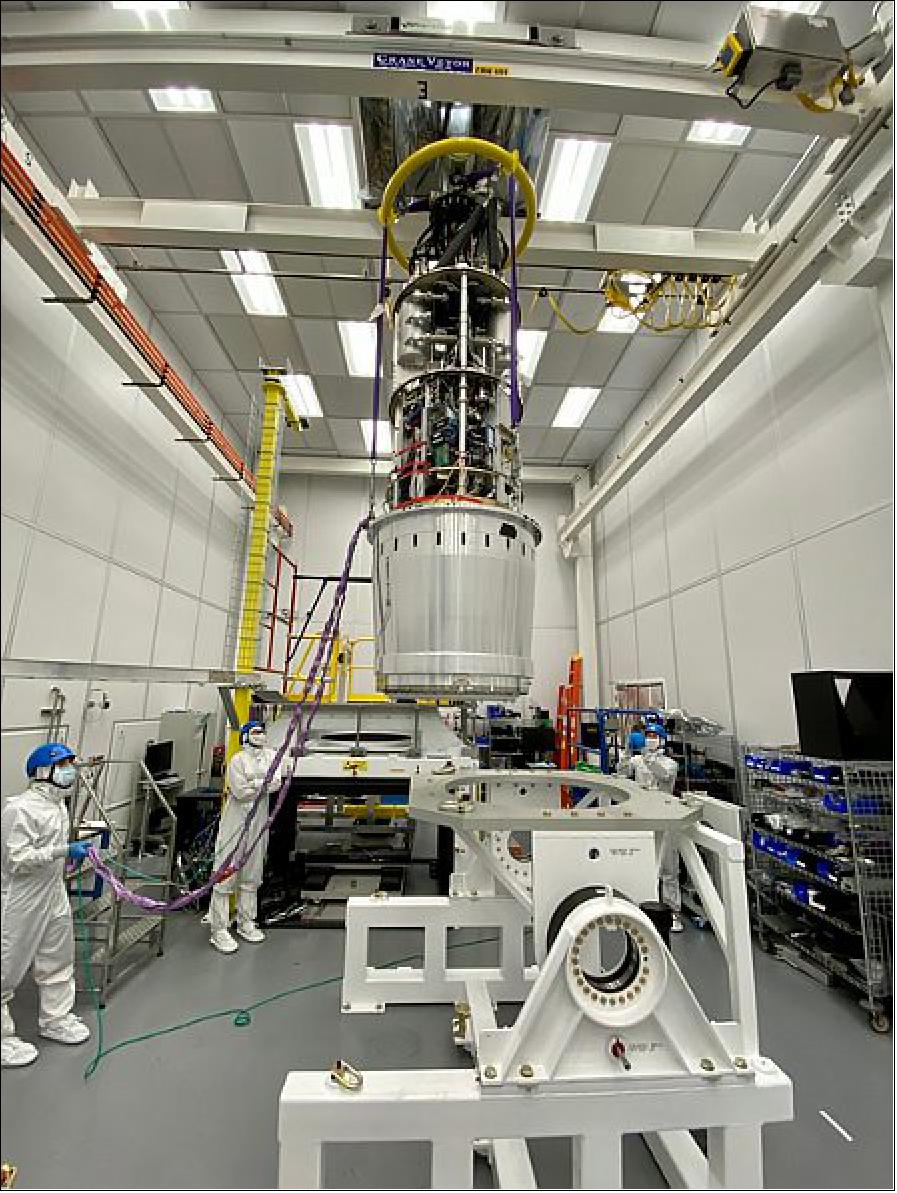
• October 19, 2021: The last of the six Rubin Observatory LSST Camera filters arrived at SLAC National Accelerator Laboratory in September, an event that marked the completion of the major camera components and the end of years of work by engineers at Lawrence Livermore National Laboratory (LLNL), who designed and managed the fabrication of the camera's lenses and filters. 6)
- The LSST Camera has three lenses that will focus and direct light from space to the camera's focal plane. The largest of these lenses, measuring 5.1 feet (1.57 meters) in diameter, was recently added to the Guinness Worlds Records—it's the largest lens in the world! This lens and its two companion lenses, at 3.94 ft (1.2 m) and 2.4 ft (.72 m), were completed and shipped from LLNL to SLAC in 2019.
- The six LSST Camera filters, labeled u, g, r, i, z, and y, are some of the largest optical filters ever produced, and will be used by Rubin Observatory to capture images of the sky in six bands of the electromagnetic spectrum, ranging from the near ultraviolet to the near-infrared. Each filter is about 30 in (76 cm) in diameter, and weighs about 90 lbs (41 kg). An automated filter exchange system, which was built at IN2P3 in France and shipped to SLAC in 2020, will rotate and switch out the filters in the camera during observations.
- With the delivery of the last filter to SLAC, the LSST Camera Major Item of Equipment (MIE) project was formally closed. That's an exciting milestone for Rubin Observatory; it means that these optical components are ready to be integrated into the LSST Camera—the highest resolution digital camera in the world (another Rubin Observatory world record).
- Work on the LSST Camera continues, supported by US Department of Energy (DOE) Commissioning funds. Next steps include final integration of all the camera components and extensive testing at SLAC, and shipping the camera to Chile in mid-2022.
• September 28, 2021: Dynamic things are happening on the summit of Cerro Pachón; the era of static components is ending, and the telescope is on the move! Testing of the hydrostatic bearing system of the Telescope Mount Assembly (TMA) was successfully conducted in mid-September—during this process the TMA was manually rotated in azimuth and elevation for the first time since testing at the Asturfeito factory in Spain. 7)
- The TMA left Spain and was shipped to Chile in August 2019. Once all the components of the TMA arrived on Cerro Pachón, the process of installing it in the summit facility began, but then had to be put on hold in March 2020 because of the COVID-19 pandemic. During the ~10 months that construction was either completely halted, or confined to essential activities, the TMA was stored safely inside the dome enclosure (which wasn't complete yet) under a weatherproof polyurethane tarp and inspected regularly by the small teams who were permitted to visit the summit. Completing the dome enclosure was a critical task that was given priority as soon as the Summit Dome team gained access to the summit; now the finished dome enclosure is complete and provides full protection for the TMA.
- As construction activities started to ramp back up in late 2020, the Rubin summit teams focused on the deployment of the utility systems (including power, oil, and coolant) required for the telescope to operate. Once international contractors were able to enter Chile and work on the summit again, things started moving more quickly, and in September 2021 it was time to awaken the TMA from its long sleep.
- The hydrostatic bearing system for the TMA is a complex combination of state-of-the-art industrial bearings and a high-pressure hydraulic oil film provided by the summit facility power plant. It allows the ~300-ton telescope structure to lift about 70 µm (the approximate diameter of a human hair) above the pier track rail. The film of oil creates an almost zero-friction interface, which means that the enormous structure can be rotated in azimuth by just a few people using their hands.
- During the tests, the TMA was also successfully rotated in elevation, from zenith to horizon. This rotation requires the accurate balance of the surrogate masses standing in for the future optical systems: the Primary/Tertiary Mirror (M1M3), the Secondary Mirror (M2) and the LSST Camera.
Figure 4: On the summit, the Telescope Mount Assembly (TMA) began moving manually in azimuth and elevation on a thin film of oil in early September - for the first time since factory testing in Spain! Multiple rotations have now been performed, and the hydrostatic bearing system is working within specifications (video credit: Vera C. Rubin Observatory)
- As a result of the manual tests, contracted personnel on the summit were able to confirm that the hydrostatic bearing pads were in good shape after the time in storage, and that the hydrostatic bearing system is operating within specifications. From here, the Rubin summit teams will continue work on installing the motors and completing the utility systems; these tasks will keep the teams busy through the end of 2021. Another exciting milestone, installation of the Commissioning Camera at the Top End of the telescope, is scheduled for early 2022.
• As of January 2020, the former Large Synoptic Survey Telescope (LSST) has been renamed the NSF Vera C. Rubin Observatory, making it the first national U.S. observatory to be named after a female astronomer. Announced at the 2020 American Astronomical Society winter meeting, the name recognizes the role Rubin played in better understanding dark matter, which will be one of the observatory survey's four main themes. 8)
- "Named after an astronomer who provided important evidence of the existence of dark matter, the NSF Vera C. Rubin Observatory seems destined to make science history with its extraordinary capabilities that will come to bear in the next few years," said France Córdova, National Science Foundation director. "Congress has helped make this inspiring commemoration a reality. The Rubin Observatory is expected to significantly advance what we know about dark matter and dark energy, so the Rubin name will have yet another way to inspire women and men eager to investigate."
- The initiative to rename the observatory was started in June 2019 by House Science, Space and Technology Committee Chairwoman Eddie Bernice Johnson and Congresswoman Jenniffer González-Colón and was enacted into law on Dec. 20, 2019.
- Science operations at the Rubin Observatory, located on Cerro Pachón in Chile, will start in 2022. The observatory consists of an integrated system featuring a wide field ground-based telescope with an 8.4-meter mirror, a 3,200-megapixel camera built by the Department of Energy (DOE), an automated data processing system, and an online public engagement platform. The construction and operations of the Rubin Observatory and its DOE LSST Camera is a U.S. federal partnership of NSF and DOE, with private and international contributors.
- "It is fitting for this major new observatory, which includes the study of dark matter and dark energy as one of the major research topics, to be named for a pioneering astronomer whose observations were so critical to our understanding of this area," said Paul Dabbar, DOE undersecretary for science. Dr. Rubin's life and singular achievements as a scientist remain a model for all those seeking to satisfy humanity's unceasing curiosity about our universe."
- During its first 10 years, this system will deliver an unprecedented optical survey of the visible sky – to be named the Legacy Survey of Space and Time. The survey's design is driven by four themes: probing dark energy and dark matter, taking an inventory of the solar system, exploring the transient optical sky, and mapping the Milky Way.
- Rubin Observatory Director Steve Kahn said, "We are deeply honored to have our observatory named after Vera Rubin. Through her discovery of flat rotation curves in galaxies, which provided strong evidence for the existence of dark matter, Vera made one of the most important contributions to science in the past century, not only for astronomy, but also for fundamental physics. When construction is completed in 2022, the Rubin Observatory and the LSST Camera will help build on her pioneering work to dramatically improve our understanding of the Universe on many different scales."
- Vera Rubin's work spanned several areas in observational astronomy, but she is most recognized for uncovering the discrepancy between the observed and predicted motions of matter in galaxies. This discrepancy is interpreted as evidence for dark matter, which exerts gravitational force but does not emit light. Her work was confirmed using numerous observational techniques, and it has had a major impact on cosmology.
- Although Vera Rubin received many scientific honors, such as the National Medal of Science and being voted into the National Academy of Sciences, she experienced gender-based resistance early in her career. She was an outspoken advocate for women in the sciences, recognized for paving the way for other women in astronomy, and for achieving remarkable professional success while facing challenges that her male colleagues did not have to overcome. As both a scientist and a woman, she improved the field for those who came after.
- "We are pleased LSST has now been named the Vera C. Rubin Observatory," said sons Allan, David and Karl Rubin. "We believe that this is a great way to honor our mother's achievements in astronomy and her work for equal rights for women in science."
- In addition, the telescope at the Rubin Observatory has been named the Simonyi Survey Telescope in recognition of a significant private donation made early in the construction phase used to design, develop and fabricate the telescope's primary mirror.
- The Rubin Observatory is a U.S. federal program of the NSF and DOE, with the NSF functioning as the lead federal agency and providing the majority of construction funding. In addition to NSF and Department of Energy funding, private funders also have shouldered some project construction costs through the LSST Corporation. The NSF-funded LSST Project Office for construction was established as an operating center under management of the Association of Universities for Research in Astronomy. The DOE-funded effort to build the LSST camera is managed by the SLAC (Stanford Linear Accelerator Center) National Accelerator Laboratory.
- NSF and the DOE Office of Science will continue to support the Rubin Observatory in its operations phase to carry out the Legacy Survey of Space and Time. They will also provide support for scientific research. During operations NSF funding is managed by AURA (Association of Universities for Research in Astronomy) under a cooperative agreement with NSF and DOE, funding is managed by SLAC under contract by DOE. The Rubin Observatory is operated by NSF's Optical-Infrared Astronomy Research Laboratory and SLAC.

Science Goals
The scientific questions that the Vera C. Rubin Observatory Legacy Survey of Space and Time (LSST) will address are profound: What is the mysterious dark energy that is driving the acceleration of the cosmic expansion? What is dark matter, how is it distributed, and how do its properties affect the formation of stars, galaxies, and larger structures? How did the Milky Way form, and how has its present configuration been modified by mergers with smaller bodies over cosmic time? What is the nature of the outer regions of the solar system? Is it possible to make a complete inventory of smaller bodies in the solar system, especially the potentially hazardous asteroids that could someday impact the Earth? Are there new exotic and explosive phenomena in the universe that have not yet been discovered? 9)
While the questions are profound, the concept behind the design of the LSST is remarkably simple: conduct a deep survey over an enormous area of sky; do it with a frequency that results in taking repeat images of every part of the sky every few nights in multiple bands, or segments of the electromagnetic spectrum; and continue in this mode for ten years. The result will be astronomical catalogs thousands of times larger than have ever previously been compiled containing the data necessary to begin searching for answers.
It would be impossible to list all the possible projects that LSST data will enable. However, here we list a few to give a flavor of these studies, and organize them by the four science themes that drive the LSST design (although some span more than one theme).
The Nature of Dark Matter and Understanding Dark Energy
LSST will probe the nature of dark matter and dark energy using several billion galaxies, employing a variety of methods to enable cross-checking of results. By mapping galaxies through time and space, cataloguing their masses, and studying their influence on the distortion of space-time, LSST will gain new insight into the nature of dark matter and dark energy. Of particular interest are the dynamical behavior of dark energy—how it behaves with cosmic time or with redshift—and the influence of dark matter on the development of structure on a cosmic scale.
Cataloging the Solar System
LSST's unprecedented power of discovery will be a giant leap forward in solar system studies. It will measure the properties of several million moving objects (10 to 100 times more objects than are currently available), including orbital, color, and variability information. Among the objects LSST will detect are near-Earth objects (NEOs), with its superior imaging enabling it to find asteroids as small as 140 meters in diameter and as far away as the Main Belt asteroids. Depending on the chosen survey strategy, LSST could detect between 60-90% of all potentially hazardous asteroids (PHAs) larger than 140 meters in diameter. With these much more detailed measurements of the current state of the small bodies in our Solar System, we can gain new insight into how planets form and how our solar system evolved over its history.
Exploring the Changing Sky
LSST will revolutionize time domain astrophysics, or the study of how astronomical objects vary in time. By imaging the entire night sky repeatedly, to great depth, and with excellent image quality, it will reveal new information about known kinds of variable stars and cosmic explosions, as well as discover entirely new classes of transient events. Within a minute of each change in the sky, LSST will generate an alert (a notification that a change has taken place), allowing the community to respond and catch events before they fade forever.
Milky Way Structure & Formation
LSST's gargantuan and exquisitely accurate collection of data will enable us to answer some fundamental questions regarding our home galaxy, the Milky Way. LSST will survey at least half of the sky and will make hundreds of observations of each surveyed area of sky. A single visit to the entire survey area will map more than 10 times the volume of past surveys. When stitched together in time, this set of observations will yield the motions of millions of Milky Way stars. When stacked in depth, this set of observations will yield a map over 1000 times the volume of past surveys, cataloging the colors and brightnesses of billions of new stars.
Rubin Observatory
The Rubin Observatory consists of an integrated system that combines an 8.4 meter primary mirror, the world's largest digital camera, a complex data processing system, and an online education platform. The Rubin Observatory takes advantage of new technologies to provide a qualitatively new capability for astronomy.
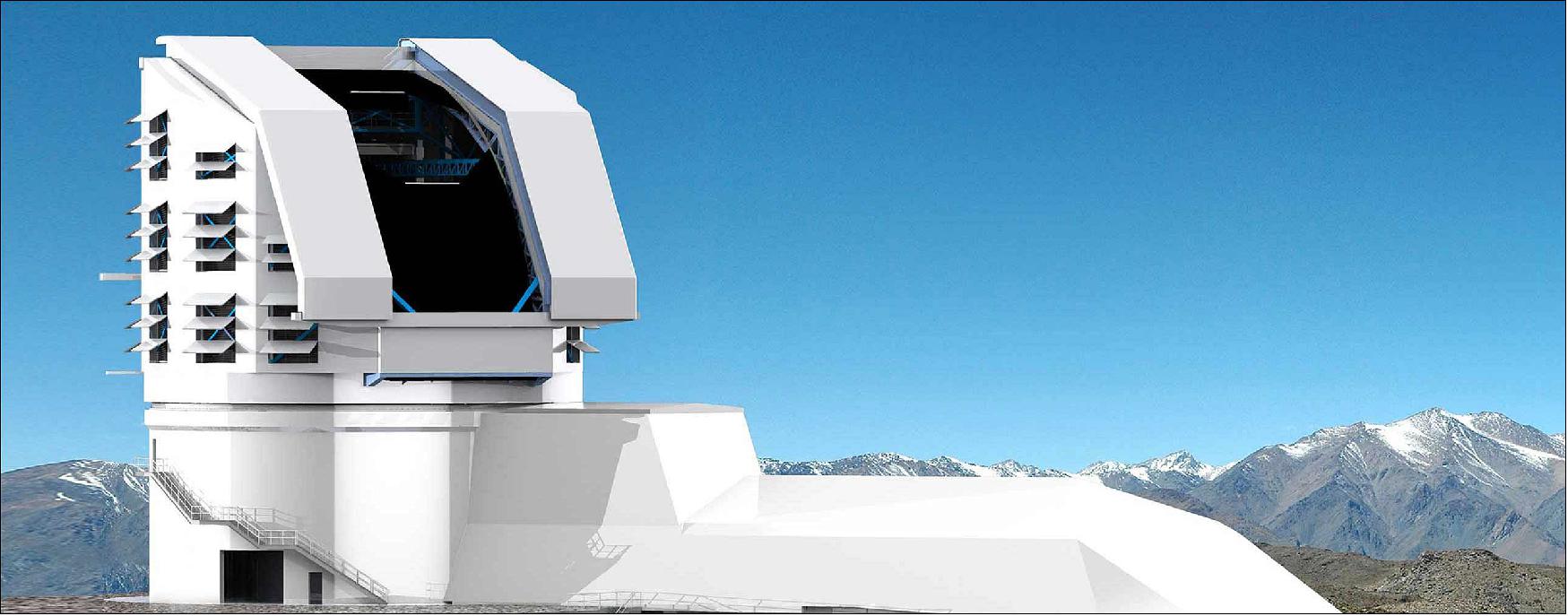
The Rubin Observatory houses the Simonyi Survey Telescope, an 8.4-meter telescope with a novel, three-mirror design, a variant of the three-mirror anastigmat, which allows a compact telescope to deliver sharp images over a very wide 3.5-degree diameter field of view. The Telescope's compact shape allows it to move quickly from one point in the sky to the next. It will image the sky continuously each night, on an automated cadence, and over the course of the ten-year survey will collect about 800 images of each location in the sky.
The primary mirror (M1) is 8.4 meters in diameter, the secondary mirror (M2) is 3.4 meters in diameter, and the tertiary mirror (M3), inside the ring-like primary, is 5.0 meters in diameter. The three-mirror telescope feeds a three element refractive corrector to produce a 3.5-degree diameter field of view over a 63-cm flat focal surface with excellent image quality. The camera housing carries five onboard filters (a manual cartridge holds a sixth) to support imaging in six spectral bands. Each inserted filter configuration requires the refocusing of the camera body relative to M3 via the camera hexapod. 10)
The evolution of the telescope optical system focused on the following goals:
1) Maintaining large integrated throughput with minimal vignetting
2) Limiting camera cantilever for mounting
3) Reducing M2 fabrication risk by decreasing its aspheric departure
4) Maintaining excellent, uniform image quality across grizY bands
5) Reducing lens fabrication risk by simplifying null tests
6) Enable camera installation through M2 inner diameter
The proximity of the primary and tertiary surfaces (233.8mm vertex separation) enables fabrication of both mirrors from a single substrate. This unique design, referred to as the M1/M3 monolith, offers significant advantages in the reduction of degrees of freedom during operational alignment and improved structural stiffness for the otherwise annular primary surface. An unused 50 mm diameter radial zone between the two surfaces will define the M1/M3 clear apertures.
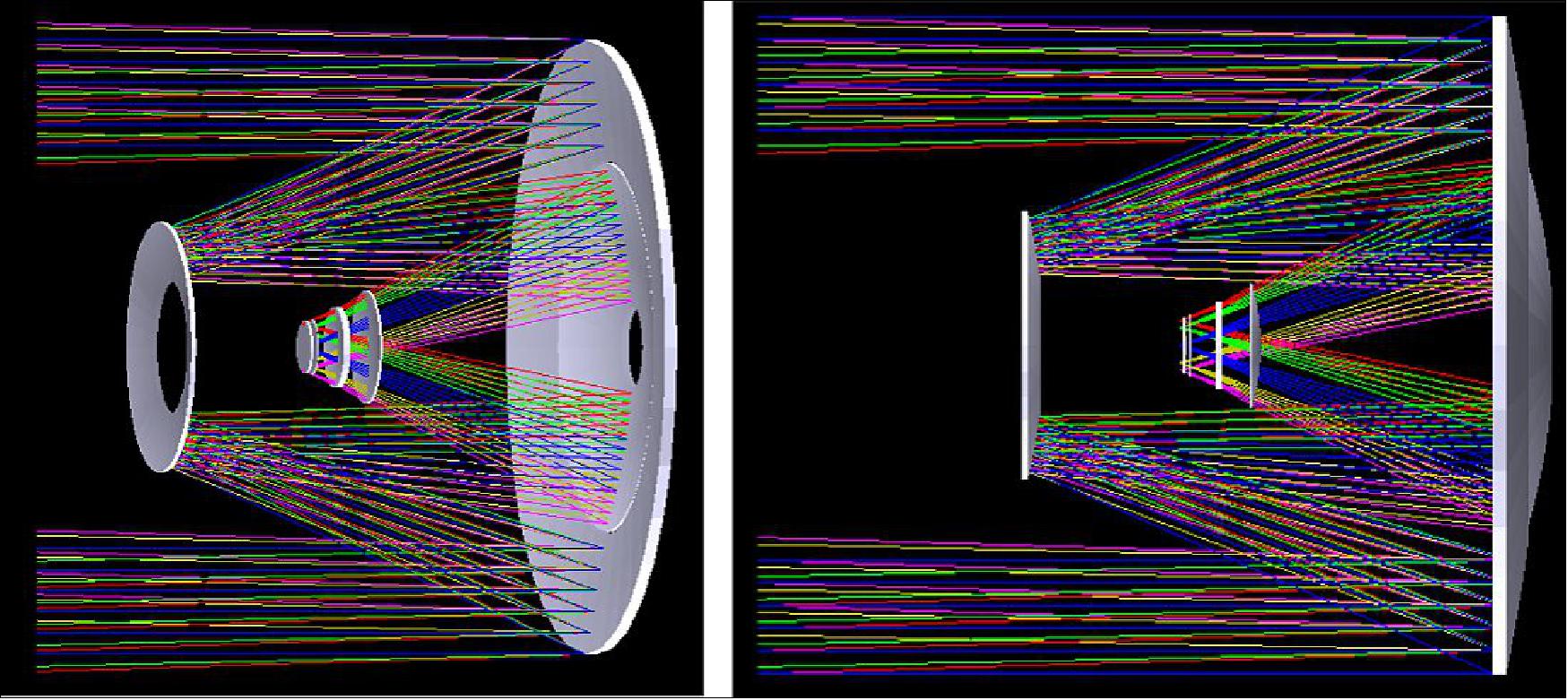
The primary and tertiary mirrors (M1 and M3) are designed as a single piece of glass, the "M1M3 monolith". Placing the two mirrors in the same location minimizes the overall length of the telescope, making it easier to reorient quickly. Making them out of the same piece of glass results in a stiffer structure than two separate mirrors, contributing to rapid settling after motion.
The primary mirror, the most critical and time-consuming part of a large telescope's construction, was made over a 7-year period by the University of Arizona's Steward Observatory Mirror Lab, Tucson, AZ.

LSST Camera
September 8, 2020: Crews at the Department of Energy's SLAC National Accelerator Laboratory at Stanford have taken the first 3,200-megapixel digital photos (or 3.2 Gpixel) – the largest ever taken in a single shot – with an extraordinary array of imaging sensors that will become the heart and soul of the future camera of the Vera C. Rubin Observatory. 11)
The images are so large that it would take 378 4k ultra-high-definition TV screens to display one of them in full size, and their resolution is so high that you could see a golf ball from about 15 miles away. These and other properties will soon drive unprecedented astrophysical research.
Next, the sensor array will be integrated into the world's largest digital camera, currently under construction at SLAC. Once installed at Rubin Observatory in Chile, the camera will produce panoramic images of the complete Southern sky – one panorama every few nights for 10 years.
Figure 9: Ranked as the top ground-based national priority for the field for the current decade, Vera C. Rubin Observatory, formerly known as the LSST (Large Synoptic Survey Telescope), is currently under construction in Chile. The U.S. Department of Energy's SLAC National Accelerator Laboratory is leading the construction of its camera – the largest digital camera ever built for astronomy, which will be mounted on the Simonyi Survey Telescope. During the first 10 years of operations, Rubin Observatory will conduct the Legacy Survey of Space and Time (LSST) of the entire southern sky and provide the widest, fastest and deepest views of the night sky ever observed. SLAC Professor Steven M. Kahn is the director of the observatory, and SLAC personnel are also participating in the data management. Rubin Observatory is a federal project jointly funded by the National Science Foundation and the Department of Energy, with early construction funding received from private donations through the LSST Corporation (video credit: LSST, Stanford)

Financial support for LSST comes from the National Science Foundation (NSF) through Cooperative Agreement No. 1258333, the Department of Energy (DOE) Office of Science under Contract No. DE-AC02-76SF00515, and private funding raised by the LSST Corporation. The NSF-funded LSST Project Office for construction was established as an operating center under management of the Association of Universities for Research in Astronomy (AURA). The DOE-funded effort to build the LSST camera is managed by the SLAC National Accelerator Laboratory (SLAC).
The NSF is an independent federal agency created by Congress in 1950 to promote the progress of science. NSF supports basic research and people to create knowledge that transforms the future. NSF and DOE will continue to support LSST in its Operations phase. They will also provide support for scientific research with LSST data.
Camera design
The LSST Camera project is funded by the DOE and managed by SLAC. Construction began in 2015 in SLAC's new clean room, as the lab is leading the camera's design and fabrication. The 3.2-Gpixel prime focus digital camera will take a 15-second exposure every 20 seconds, which requires very precise focusing due to the rapid repointing. It will produce data of extremely high quality with minimal downtime and maintenance.
Length | 3.73 m |
Height | 1.65 m |
Mass | 2800 kg |
Pixel count | 3200 Mpixel |
Wavelength range | 320–1050 nm |
Focal Plane
The focal plane is the heart of the camera, where light from billions of galaxies comes to a focus. It consists of 189 CCDs (Charge-Coupled Device), arranged in a total of 21 3 x 3 square arrays, mounted on platforms called rafts. The system is cooled to about -100 °C to minimize noise.
The 64-cm-wide focal plane corresponds to a 3.5º FOV (Field of View), which means the camera can capture more than 40 times the area of the full moon in the sky with each exposure.

Filter Changer
The camera also contains a carousel that holds five on-board filters. Each of the filters can be individually swapped out in under two minutes and up to four times a night with the double-rail auto changer. The system also integrates with a manual load-lock changer to allow for a swap-out of a sixth filter. 12)

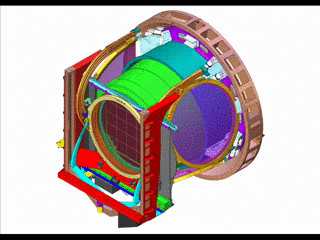
The optimized wavelength range for the LSST Camera is 320–1050 nm (near ultraviolet to near infrared). This range is divided into six spectral bands labeled u-g-r-i-z-y, each associated with one of the filters. For example, an infrared, or "i" filter might be used to observe sources obscured by dust, since infrared wavelengths can pass through the dust.

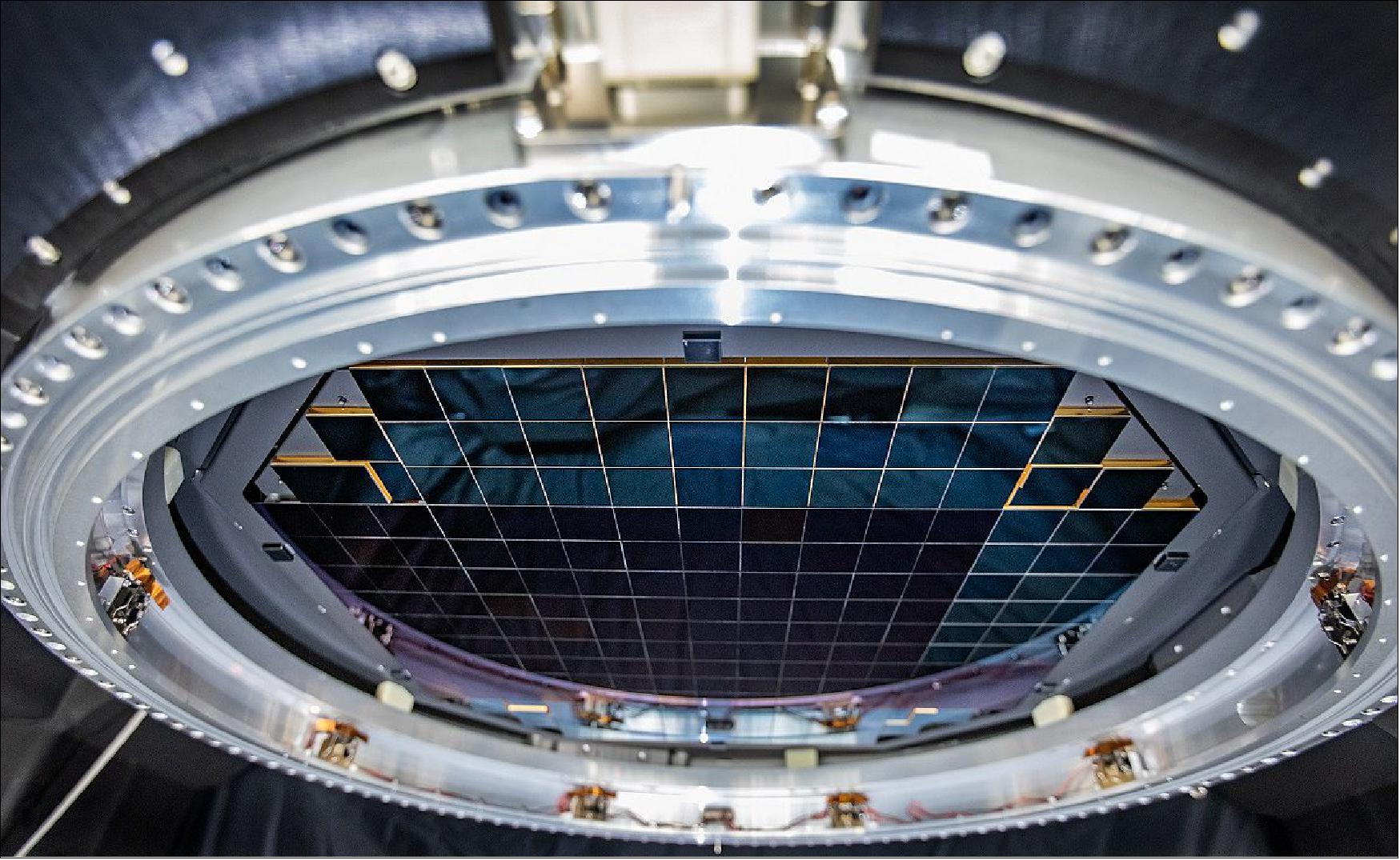
References
1) "Vera C. Rubin Observatory," Wikipedia, URL: https://en.wikipedia.org/wiki/Vera_C._Rubin_Observatory
2) "Rubin Observatory Premieres its New Logo," LSST, 3 December 2020, URL: https://www.lsst.org/news/rubin-observatory-premieres-its-new-logo
3) "About Rubin Observatory," URL: https://www.lsst.org/about
4) https://beta.nsf.gov/funding/opportunities/vera-c-rubin-observatory
5) "Camera Cooldown," Vera C. Rubin Observatory, 12 November 2021, URL: https://project.lsst.org/
6) "Optical Achievements," Vera C. Rubin Observatory, 19 October 2021, URL: https://www.lsst.org/news/optical-achievements
7) "The TMA Awakens," Vera C. Rubin Observatory, 28 September 2021, URL: https://project.lsst.org/tma-awakens
8) "NSF-supported observatory renamed for astronomer Vera C. Rubin," NSF News Release 20-001, 7 January 2010, URL: https://www.nsf.gov/news/news_summ.jsp?cntn_id=299739
9) "Vera C. Rubin Observatory Science Goals," LSST, URL: https://www.lsst.org/science
10) William Gessler, "LSST Optical Design Summary," LSST System Engineering Controlled Document, 1 May 2009, URL: https://web.archive.org/web/20120320215936/
http://www.lsstcorp.org/nsfmaterialsdec09/LSST%20Optical%20Design%20Summary.pdf
11) Manuel Gnida, "Sensors of world's largest digital camera snap first 3,200-megapixel images at SLAC," Stanford University, 8 September 2020, URL: https://www6.slac.stanford.edu/news/
2020-09-08-sensors-world-largest-digital-camera-snap-first-3200-megapixel-images-slac.aspx
12) https://www.lsst.org/about/camera
The information compiled and edited in this article was provided by Herbert J. Kramer from his documentation of: "Observation of the Earth and Its Environment: Survey of Missions and Sensors" (Springer Verlag) as well as many other sources after the publication of the 4th edition in 2002. - Comments and corrections to this article are always welcome for further updates (eoportal@symbios.space).